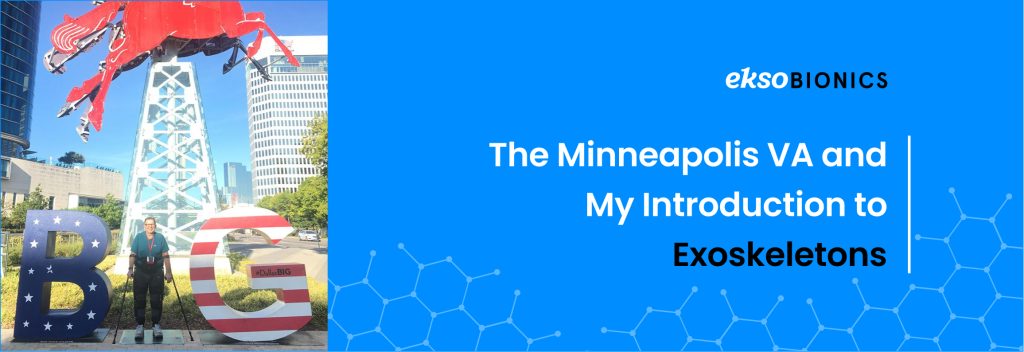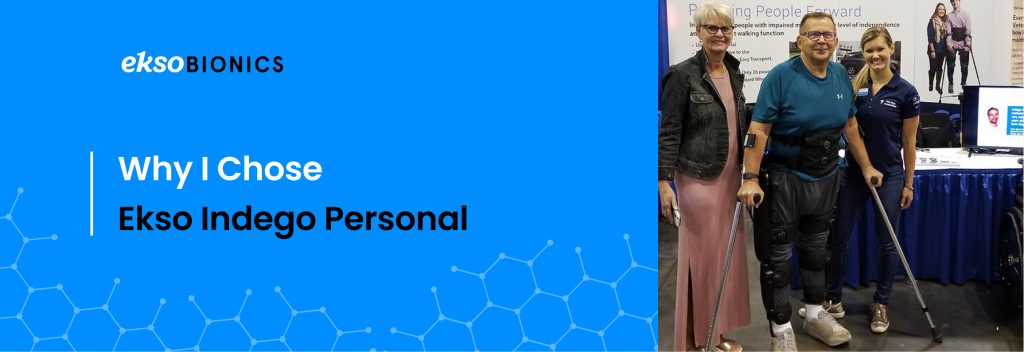My name is Jim Dahlin. I’m an army veteran who served as a combat medic with the 4th infantry division in Vietnam from 1969-70. I was discharged in June of 1971 and used the GI bill to become a nurse anesthetist. When I was 48, I could ride a bicycle across the US from Seattle to Williamsburg, Virginia, in 24 days averaging 140 miles a day. Two short years later, at the age of 50, I was unable to even get on a bicycle. I had been diagnosed with a spinal cord injury, which eventually put me in a wheelchair.
The Minneapolis VA and My Introduction to Exoskeletons

I didn’t get involved with the VA until 2014 when I had an MRI done at the Minneapolis VA. I needed to have my baclofen pump checked before I could be discharged and had to go to the SCID (spinal cord injury or disease) center. When I met with the physician there, she told me that my disease qualified me to be seen and treated at the SCID center. As part of my two-day physical, I was seen by a physical therapist who asked me if I would be willing to try a new therapy device. This new therapy device was an exoskeleton called the Ekso NR. I attended physical therapy three days a week for five weeks. It was so nice to stand and move. Unfortunately, the Ekso was only for therapy and not for home use.
After a few weeks, I got a call from another therapist in the SCID who was looking for people to try the ReWalk exoskeleton, which was approved for home use. I went through training for three weeks to learn how to use the device. Since you need to have someone with you using the exoskeleton, my wife went through some of the training with me. After completing my training, I was approved to take it home for a three-month trial. After my trial period ended, I returned the device and was asked if I wanted to have it purchased on my behalf by the VA. Later, I found out that another device was launching for trial in the next few months, so I decided to try the new exoskeleton as well before I made a decision.
Why I Chose Ekso Indego Personal

When the Ekso Indego Personal exoskeleton launched, my wife and I attended and completed the training for it at the Minneapolis VA. I was then given the opportunity to take the Ekso Indego Personal home for a three-month trial. During my trial period, Indego made some changes to the exoskeleton. They sent me the new components with each change, so my trial period was extended to give me the opportunity to test all the new components.
I made the decision to go with Ekso Indego Personal for a few reasons. I can make adjustments to such things as step height and step length while walking in the device. Its five-piece design makes it easy to assemble and put on, and if I spend some time away from my home, it has a travel case to store it in.
The thing I love most about exoskeletons is the ability to stand, walk, and look someone straight in the face while talking. Those of us in chairs know how tiring it can be on our necks to look up at someone who is standing and carry on a long conversation. It’s also good for the overall body to stand and move. I generally walk in the device for 30-45 minutes, 2-3 times a week. Living in Minnesota, the winter poses some problems when it gets too cold, or the sidewalks become slippery from ice and snow. Because the Ekso Indego Personal is slim and lightweight, I can get in my car while wearing the device, giving me the option to go to a mall or large store and walk with it during the winter months.
If you are currently in a wheelchair, I recommend speaking with the physical therapist in your SCID to see if you physically qualify for the use of an exoskeleton. If you do qualify, I highly encourage you to do a trial with your therapist. I know that not every SCID has an exoskeleton in-house. If yours does not, contact Ekso today to make an inquiry.